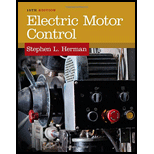
Concept explainers
Why is it desirable to remove the autotransformers from the line when the motor reaches its rated speed?
Explain the reason why it is desirable to remove the autotransformer starters from the line when the connected motor reaches its rated speed.
Explanation of Solution
Autotransformer starter is placed between the motor and supply power lines to limit the supply voltage that is provided across the terminals of the motor during accelerating of the connected motor. With the lower accelerating voltage, motor draws less current and produces less torque in motor. Taps are provided on the autotransformer starters to permit the user to initiate the motor at an increasing speed from 50 percent, 60 percent, 75 percent or 85 percent of the line voltage.
The autotransformer starters are removed from the line connection when the motor attains the rated speed to obtain the required electrical energy by removing the magnetizing current, iron, and copper losses. Generally, the insulating life of the autotransformers may extend due to reduced heat and voltage applications.
Conclusion:
Thus, the reason why it is desirable to remove the autotransformer starters from the line when the connected motor reaches its rated speed is explained.
Want to see more full solutions like this?
Chapter 27 Solutions
Electric Motor Control
- Don't use ai to answer I will report you answerarrow_forwardDon't use ai to answer I will report you answerarrow_forwardPlease write all the Formulas clearly for each case first, then solve the question by hand on paper and send a clear photo of the solution. Thanks a lot Power Electronics Q1) For the circuit shown in Fig (1). (a) Draw the output voltage and load current waveforms if the load is inductive. Explain the working of each device. (b) If Vs 220V, load resistance is 10 2 and output voltage frequency is 50Hz. 1. What is the rms value of the load voltage? 2. Obtain Fourier series expression of the output voltage up to 7th order harmonic. 3. Draw the frequency spectrum of the output voltage wave up to 7th order harmonic. T₁ D₁ D Vo T₁ D4 Fig 1 Load T₂ Darrow_forward
- Please write all the formulas clearly for each case first, then solve the question by hand on paper and send a clear photo of the solution. Thanks a lot 6 A three-phase transistor voltage-source inverter supplies a three-phase load, as shown in Fig.8.41. The load consists of star connected resistance of 10 in each phase. The inverter supply voltage is 200V d.c. and each inverter switch conducts for 120°. (a) Sketch the switching signals for the six transistors. (b) Sketch the line-to-neutral voltage for one complete cycle of the output voltage. (c) Sketch the line-to-line voltage for one complete cycle of the output voltage. (d) Calculate the rms values of the first five harmonics in the line- to-line output voltage, including the fundamental. (e) Calculate the rms values of the first five harmonics in the line- to-neutral output voltage, including the fundamental. [Ans: (d) VL-L=244.95 V, (e) Vph = 141.42 V] Q1 Q3 Q5 Vdc 200V b Q4 Q6 Q2 Fig.8.41. 120° conuction ww 102 w 1052 ww n 1052arrow_forwardPlease write all the Formulas clearly for each case first, then solve the question by hand on paper and send a clear photo of the solution. Thanks a lot Tent waveforms if the Q4) A three-phase inverter supplies a 3-phase load, as shown in Fig (2). The load consists of star connected resistance of 1002 in each phase. The inverter supply voltage is 200 V dc, and each inverter switch conducts 180°. (a) Sketch the switching signals for the six transistors. (b) Sketch the line-line voltage for one complete cycle of the output voltage (c) Sketch the line-line voltage for one complete cycle of the output voltage (d) Calculate the rms values of the first five harmonics in the line-line output voltage, including the fundamental. (e) Calculate the rms values of the first five harmonics in the line-neutral output voltage. including the fundamental.) Vac 200V Q1 Q3 Q5 B Q6 b Q2 ww 10Ω Fig2 3 1092 ww 1092arrow_forwardPlease write all the formulas clearly for each case first, then solve the question by hand on paper and send a clear photo of the solution. Thanks a lot A three-phase bridge-inverter is fed from a d.c. source of 200 V. If the load is star-connected of 10 02/phase pure resistance, determine the RMS load current, the required RMS current rating of the thyristors and the load power for (i) 120° firing, and (ii) 180° firing. [Ans (i) 120° firing IL (rms) = 8.16 A, IT(rms) = 9.8 A. Load power = 2000 W. (ii) 180° firing IL (rms) = 9.43 A, IT (rms) = 6.67 A. Load power = 2667 W.]arrow_forward
- SIM1 RESET O SIMULINO ARDUINO AREF 13 12 -11 www.arduino.cc blogembarcado.blogspot.com SIMULINO UNO BUZ1 BUZZER R1 R2 51.1 68.1 GAS1 MQ-2 GAS SENSOR MQ-2 TestPin www.TheEng Vcc OUT GND Can the expt help me write Arduino code for the Project sensou pas?arrow_forwardSolve this problem and show all of the workarrow_forwardSolve this problem and show all of the workarrow_forward
- Solve this problem and show all of the workarrow_forwardSolve this problem and show all of the workarrow_forwardA 3 km long multimode step index fibre operating at a bandwidth of 4 Mhz has a core refractive index of 1.48 and a refractive index difference of 1 %. Evaluate the rms pulse broadening per kilometer which results from chromatic dispersion.arrow_forward

 Electricity for Refrigeration, Heating, and Air C...Mechanical EngineeringISBN:9781337399128Author:Russell E. SmithPublisher:Cengage Learning
Electricity for Refrigeration, Heating, and Air C...Mechanical EngineeringISBN:9781337399128Author:Russell E. SmithPublisher:Cengage Learning

